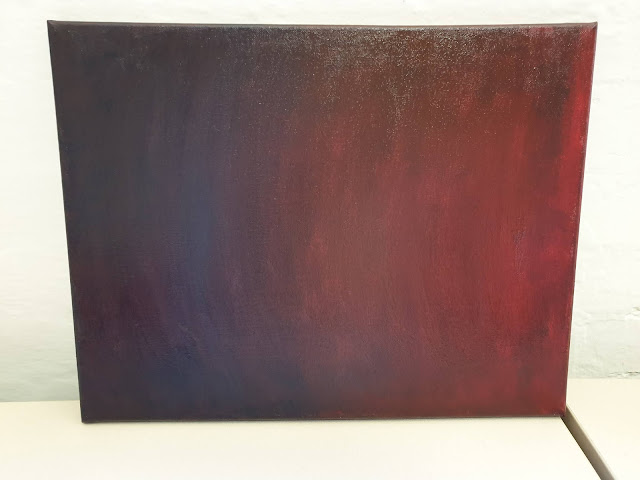Almost two months ago I posted an old piece of space art of mine that I was intending to turn into a physical painting. At this point in time I'm close enough to finished with it that I might as well show it off, especially since I didn't have space to bring it home with me from uni when I last left so I probably won't be working on it for some time. (I only had enough hands to carry my desk plants.)
If you recall, the original picture looked like this:
The painting currently looks…a bit different. The reason why is actually rather interesting; I decided that for this painting, instead of painting a simple flat black background as I've been doing for my space pictures, I instead wanted to paint a gradient going from dark red to dark blue to make the background more dynamic. Here's that gradient after I painted it:
At this point I realized that the gradient looked like the light was coming from off the edge of the canvas rather than from a star mostly on it, so I decided to shift the composition so that the star was covering the right edge of the canvas. Then I decided to make the star much bigger (so that most of it was actually off the edge of the canvas), and add a massive stellar flare erupting into space. And then I decided I might as well move the planet into more of a profile view and out from in front of the star. Here's what it looked like before I added the planet:
You'll notice it's also gone from landscape to portrait orientation; I think it looks more interesting this way. (Looking at it now, I'm reminded that I've read S-shapes in paintings can catch the eye, so maybe that has something to do with it.) You can see (or maybe you can't here) that I've done my favorite trick of using glass beads in the paint on the star, which gives it a remarkably dynamic look in person. Anyway, here's my first try at a planet roasting in the fiery heat of its parent star:
I definitely didn't like how the planet came out here, so I tried again. (Though the star looks amazing photographed on that red chair like that!) Finally, here's what the painting looks like at the moment:
I tried making the planet look a lot hotter, and think I've mostly succeeded in that; I also tried to make it look like the atmosphere is being blown off by the solar wind pressure, and I'm much less happy with how that came out. (Someone noted it looks like the planet is plunging into the star, and now I can't unsee that.) It also looks rather like the star is reaching out a grasping tendril to grab the hapless planet, which was also not my intention, but which I do find to be rather cool. I am quite happy with how the star and flare turned out; I've discovered I really like painting both of those things, and if I flatter myself, I think I'm getting halfway-decent at it.
The decision to move the planet to a side view like this was also partly inspired by the discovery of a hot Jupiter in an astonishingly-tight 18 hour orbit back in February, in a coincidental nod to the inspiration behind the original piece of art. In the linked article they note that the planet they found, NGTS-10b, has an orbital distance only twice the diameter of its parent star (a fairly Sun-like star, though about a thousand kelvins cooler). Which would put it a bit further out than this planet, but not a whole lot. (For reference, that's some 27 times closer than Mercury is to our Sun.)
I don't actually have a name for this painting at the moment, and I'll probably wait on one until I can get back to it and try to improve the planet and its escaping atmosphere a bit. In the meantime I figured I'd share it with you all rather than waiting till I could properly finish it. It's 14”×18”, if you were wondering. A hui hou!





No comments:
Post a Comment
Think I said something interesting or insightful? Let me know what you thought! Or even just drop in and say "hi" once in a while - I always enjoy reading comments.